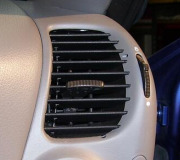I think something was lost in translation. Where would "hot air" come from?
Most automotive AC systems have low-pressure cutout switches. Its purpose is to prevent the compressor from turning on when most of the refrigerant has leaked out. If the compressor could run that way there is a chance it could draw in outside air on the low side through a leak if it got drawn into a vacuum. The issue is humidity getting drawn in, not the air itself. Moisture will prevent the system from working properly in the short-term, even if refrigerant is added, and it will cause corrosion to metal parts in the long-term. That's why the proper way to service the system is to evacuate it into a vacuum for at least half an hour before adding refrigerant. In a vacuum water boils at 77 degrees and will be sucked out.
Adding refrigerant from the small cans can result in real expensive repairs. There is absolutely no way to know how much is already in there unless all of it is recovered, then a carefully measured amount is injected. That's why all shops doing AC work have the very expensive equipment that your labor charge helps pay for. When too much refrigerant is in the system there is too much liquid and not enough vapor. The liquid will turn to a vapor in the wrong place, namely, outside the passenger compartment under the hood. Where it becomes a vapor is where it gets cold, so you're cooling the engine, not you. The bigger problem is AC compressors can be destroyed if liquid sloshes into them. They can only pump a vapor which can be compressed. When the system has the correct amount of refrigerant, it will turn from liquid to vapor in the evaporator in the dash and no liquid will get close to the compressor.
The first question is how did the system get overcharged? The next question is how could anyone know how much to let out and what kind of equipment was used? At either step there is no way to know how much refrigerant is in the system, even with gauges attached. Only older Chrysler systems used a sight glass. When the bubbles stopped showing up, it was fully-charged. Ford tried to do that in the '90s but it was worthless. There would be bubbles in the sight glass even when the system was fully-charged so a lot of do-it-yourselfers kept adding until they took out the compressors.
When refrigerant is removed from the system, the pressure in it goes down. That allows some of the liquid that is still in there to vaporize and expand. By expanding the pressure goes right back up to where it was. As long as there is still a hint of liquid in the system you will have full pressure, no matter how much you let escape. So the third question is how did your husband determine it was overcharged?
Also be aware that refrigerant is extremely dangerous to work with. It can cause frostbite and blindness. Most professionals wear gloves, safety glasses, and a face shield.
If the system DID magically fill itself with air, it did that through a leak. If there is a leak the refrigerant would leak out, and so would that air.
Wednesday, April 18th, 2018 AT 10:10 AM
(Merged)



